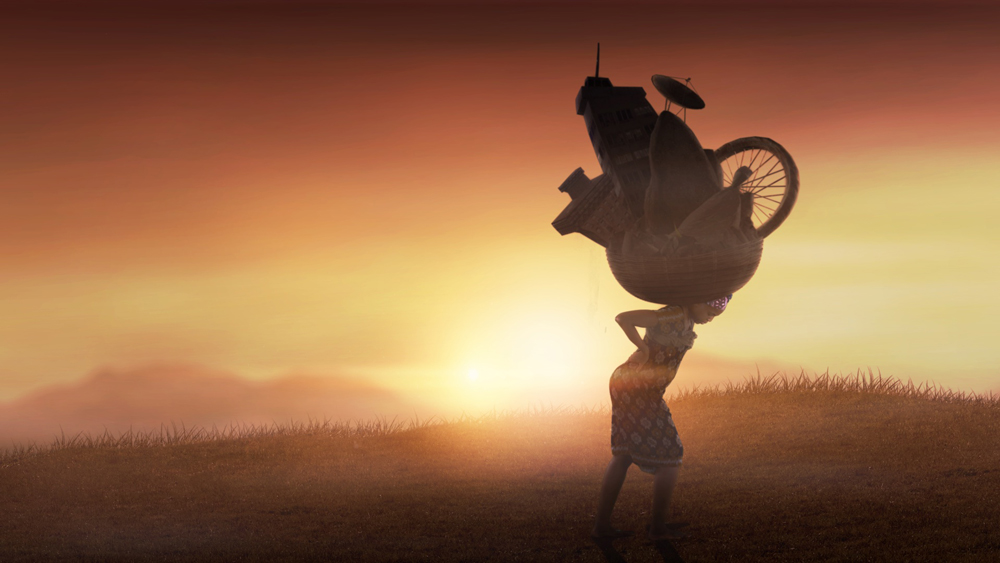
3-channel animated video, color, sound, 10:45 min; 2015. Courtesy of the artist and Gladstone Gallery, Victoria Miro, and Vielmetter Los Angeles.
COLLAGE EVENT
“Wangechi Mutu: Intertwined” Film Screenings
at the New Orleans Museum of Art in New Orleans, Louisiana, USA
Wednesday, 12 June 2024, Noon-7PM
This special screening of Wangechi Mutu’s films is taking place just before the start of Kolaj Fest New Orleans 2024. We encourage attendees to visit the museum for these films if they have time. Museum admission fees apply.
As part of the exhibition, “Wangechi Mutu: Intertwined”, the New Orleans Museum of Art presents seven short films by the artist. The total runtime is about an hour and a half. The films will be screened in the museum’s Lapis Center for the Arts, which has ample seating and is wheelchair accessible.
Mutu’s film work confronts the missing attention to Black women within society, their labor, their experience of the world while also directing our attention to environmental destruction and cultural trauma. The films have been screened widely in art institutions for over a decade and increasingly use collage in motion as a compositional and narrative strategy.
Cleaning Earth (2006)
“The video Cleaning Earth shows a woman (Mutu herself) on hands and knees scrubbing a dirt floor with water and brush. It’s a futile effort: She becomes increasingly dirty as she merely pushes the mud around in sweeping circles. The surface of the gallery walls is alternately decorated with bright white pearls and diseased with reddish pockmarks, a reminder of the discrepancy between Cinderellas liberated by Prince Charmings and those condemned to serve others forever.” (Rebecca Dimling Cochran, Artforum, 2007)
Cutting (2004)
“Cutting shows Mutu approaching a log on a rise in a scrubby landscape. Shot against the sunset, the log at times resembles a body as Mutu hacks at it with a machete. The sound of metal on metal, an unintended result of the way she was miked, adds to the video’s disconcerting effect.” (Stephanie Cash, Art in America, 2010)
Amazing Grace (2005)
“In Amazing Grace, she showed video art rooted in the origins of the Atlantic slave trade and that casts the ocean as a duplicitous character. Mutu describes the water as both beautiful and intimidating, evoking metaphors of cleansing and drowning. In the video, she immerses herself in the sea as a gesture for embracing a new home. Its significance is not lost in Miami where illegal immigration, sexual trafficking and transience are overwhelming realities.” (Dejha Carrington, Miami Design District, 2014)
The End of eating Everything (2013)
“Wangechi Mutu’s animated video, The End of eating Everything, features the singer Santigold as a post-apocalyptic being hovering in a darkened sky. Her bulbous, tumor-like body, covered in human limbs and machine parts, throbs and emits plumes of smoke as she greedily devours a flock of birds. Mutu’s monstrous creation suggests the destructive—and ultimately self-imposed—nature of our drive to consume.” (Blanton Museum of Art, 2018)
The End of carrying All (2015)
“The End of carrying All, the animation, which can be considered a sequel to her first animated video, The End of eating Everything, shows the horror of how Wangechi Mutu sees the world ending…’A world consumed by desires, innovations and endless materialism. In a journey that started with few basic items– mainly the tools that are used to feed their families, as many African women still do on a daily basis…'” (Bukola Oyedbode, J.Jutt, 2022)
My Cave Call (2021)
“My Cave Call is a parable on wisdom seeking. Set at Mount Suswa, a holy site in Kenya, the film centers histories that have been lost and the beginning process of reclamation. A meditation on reconnection, the film recounts moments from recent and distant Kenyan history. Narrated by the off-screen voice of a young child, it presents moments of frustration but also of hope, leaving space for a renewal of wisdom that has been lost.” (Saint Louis Art Museum, 2024)
Eat Cake (2012).
“In the video, Eat Cake, a dance is enacted by another female character, whose place of origin is hard to determine from her dress code and general appearance. She materializes magically in a seat placed centrally in the video, in front of a large, dark cake that she proceeds to squat or genuflect in front of. As she starts to handle the mound, it’s obvious that her manner of eating is gluttonous and carnal. There’s a predatory, mysterious and unknowable quality to her once she has a taste of this very earthy, fecal-like meal.” (Signs: Journal of Women in Culture and Society, 2012)
INFORMATION
New Orleans Museum of Art
1 Collins C. Diboll Circle
City Park
New Orleans, Louisiana 70124 USA
(504) 658-4100
Hours:
Tuesday and Thursday-Sunday, 10AM-5PM
Wednesday, Noon-7PM
